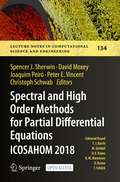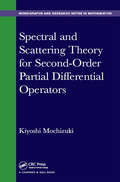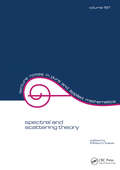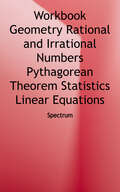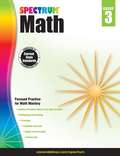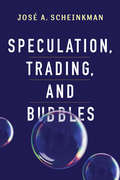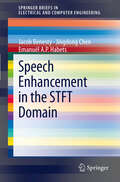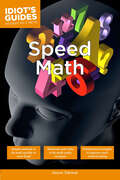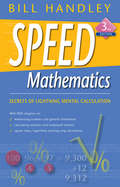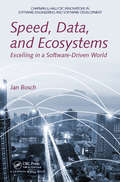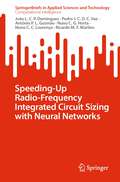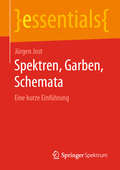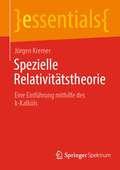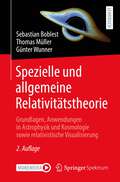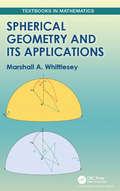- Table View
- List View
Spectral and High Order Methods for Partial Differential Equations ICOSAHOM 2018: Selected Papers from the ICOSAHOM Conference, London, UK, July 9-13, 2018 (Lecture Notes in Computational Science and Engineering #134)
by Christoph Schwab Spencer J. Sherwin David Moxey Joaquim Peiró Peter E. VincentThis open access book features a selection of high-quality papers from the presentations at the International Conference on Spectral and High-Order Methods 2018, offering an overview of the depth and breadth of the activities within this important research area. The carefully reviewed papers provide a snapshot of the state of the art, while the extensive bibliography helps initiate new research directions.
Spectral and Scattering Theory for Second Order Partial Differential Operators (Chapman & Hall/CRC Monographs and Research Notes in Mathematics)
by Kiyoshi MochizukiThe book is intended for students of graduate and postgraduate level, researchers in mathematical sciences as well as those who want to apply the spectral theory of second order differential operators in exterior domains to their own field. In the first half of this book, the classical results of spectral and scattering theory: the selfadjointness, essential spectrum, absolute continuity of the continuous spectrum, spectral representations, short-range and long-range scattering are summarized. In the second half, recent results: scattering of Schrodinger operators on a star graph, uniform resolvent estimates, smoothing properties and Strichartz estimates, and some applications are discussed.
Spectral and Scattering Theory: Proceedings Of The Taniguchi International Workshop
by Mitsuru Ikawa"This useful volume, based on the Taniguchi International Workshop held recently in Sanda, Hyogo, Japan, discusses current problems and offers the mostup-to-date methods for research in spectral and scattering theory."
Spectrum 8th Grade Math Workbook: Focused Practice for Math Mastery (Spectrum Series)
by Spectrum8th Grade Math Workbook for kids ages 13-14 <p> Support your child’s educational journey with the Spectrum grade 8 math workbook that teaches essential math skills to eighth graders. <p><p> Spectrum’s 8th grade math workbook is a great way for eighth graders to learn essential math skills such as learning Pythagorean Theorem, geometry, rational and irrational numbers, and more through a variety of problem-solving activities that are both fun AND educational! <p><p> Why You’ll Love This Math Book <p> Engaging and educational math for 8th grade students. “Using and rewriting exponents”, “solving word problems”, and “linear equations” are a few of the fun activities that incorporate math in everyday settings to help inspire learning. <p> Testing progress along the way. Pretests, posttests, a mid-test, final test, and an answer key are included in the 8th grade math workbook to help track your child’s progress along the way before moving on to new and exciting math lessons. <p><p> About Spectrum <p> For more than 20 years, Spectrum has provided solutions for parents who want to help their children get ahead, and for teachers who want their students to meet and exceed set learning goals—providing workbooks that are a great resource for both homeschooling and classroom curriculum.
Spectrum MathWorkbook, Grade 3
by Spectrum<p>The Spectrum Math Workbook for third grade features 160 pages of focused instruction and progressive practice to help students stay ahead in math and enhance problem-solving skills. <p>This standards-based workbook provides systematic and thought-provoking practice designed to increase in complexity for the following content areas: adding and subtracting to four-digit numbers, multiplying and dividing, fractions, perimeter and area, and graphs and line plots. With easy-to-follow instructions, tests, and an included answer key, parents and teachers can accurately monitor students’ progress. <p>The best-selling Spectrum series is a favorite of parents and teachers because it’s carefully designed to be both effective and engaging––the perfect building blocks for a lifetime of learning.</p>
Speculation, Trading, and Bubbles
by Joseph E. Stiglitz Patrick Bolton Kenneth J. Arrow Sanford J. Grossman José A. ScheinkmanThe history of financial markets is full of moments in which asset prices inflate far beyond their intrinsic value. These events are commonly called bubbles, and in this book, José A. Scheinkman and other top economists offer new explanations for this phenomenon.Scheinkman discusses some stylized facts concerning bubbles, such as high trading volume and the coincidence between bubbles' implosion and increases in supply, and he develops a model for bubbles based on differences in beliefs among investors that explains these observations. Sandy Grossman and Patrick Bolton offer commentaries on Scheinkman's work, investigating factors that contribute to bubbles, such as excessive leverage, overconfidence, mania, and panic in speculative markets. Kenneth J. Arrow and Joseph E. Stiglitz add introductory material contextualizing Scheinkman's findings.
Speculation, Trading, and Bubbles (Kenneth J. Arrow Lecture Series)
by José A. ScheinkmanAs long as there have been financial markets, there have been bubbles—those moments in which asset prices inflate far beyond their intrinsic value, often with ruinous results. Yet economists are slow to agree on the underlying forces behind these events. In this book José A. Scheinkman offers new insight into the mystery of bubbles. Noting some general characteristics of bubbles—such as the rise in trading volume and the coincidence between increases in supply and bubble implosions—Scheinkman offers a model, based on differences in beliefs among investors, that explains these observations. Other top economists also offer their own thoughts on the issue: Sanford J. Grossman and Patrick Bolton expand on Scheinkman's discussion by looking at factors that contribute to bubbles—such as excessive leverage, overconfidence, mania, and panic in speculative markets—and Kenneth J. Arrow and Joseph E. Stiglitz contextualize Scheinkman's findings.
Speech Enhancement in the STFT Domain
by Jacob Benesty Jingdong Chen Emanuël A.P. HabetsThis work addresses this problem in the short-time Fourier transform (STFT) domain. We divide the general problem into five basic categories depending on the number of microphones being used and whether the interframe or interband correlation is considered. The first category deals with the single-channel problem where STFT coefficients at different frames and frequency bands are assumed to be independent. In this case, the noise reduction filter in each frequency band is basically a real gain. Since a gain does not improve the signal-to-noise ratio (SNR) for any given subband and frame, the noise reduction is basically achieved by liftering the subbands and frames that are less noisy while weighing down on those that are more noisy. The second category also concerns the single-channel problem. The difference is that now the interframe correlation is taken into account and a filter is applied in each subband instead of just a gain. The advantage of using the interframe correlation is that we can improve not only the long-time fullband SNR, but the frame-wise subband SNR as well. The third and fourth classes discuss the problem of multichannel noise reduction in the STFT domain with and without interframe correlation, respectively. In the last category, we consider the interband correlation in the design of the noise reduction filters. We illustrate the basic principle for the single-channel case as an example, while this concept can be generalized to other scenarios. In all categories, we propose different optimization cost functions from which we derive the optimal filters and we also define the performance measures that help analyzing them.
Speech and Audio Processing: A MATLAB®-based Approach
by Ian Vince McloughlinWith this comprehensive and accessible introduction to the field, you will gain all the skills and knowledge needed to work with current and future audio, speech, and hearing processing technologies. Topics covered include mobile telephony, human-computer interfacing through speech, medical applications of speech and hearing technology, electronic music, audio compression and reproduction, big data audio systems and the analysis of sounds in the environment. All of this is supported by numerous practical illustrations, exercises, and hands-on MATLAB examples on topics as diverse as psychoacoustics (including some auditory illusions), voice changers, speech compression, signal analysis and visualisation, stereo processing, low-frequency ultrasonic scanning, and machine learning techniques for big data. With its pragmatic and application driven focus, and concise explanations, this is an essential resource for anyone who wants to rapidly gain a practical understanding of speech and audio processing and technology.
Speed Math for Kids: Helping Children Achieve Their Full Potential
by Bill HandleyPopular Australian author and inspirational teacher, Bill Handley, has developed and, over the years, refined methods of teaching mathematics and learning strategies that have achieved amazing results. His best-selling book, Speed Mathematics convinced readers that people who excel at maths use better strategies and are not necessarily more intelligent. This book contains additional methods and applications based on the strategies taught in Speed Mathematics that make the principles clearer, encourage creative thought, and are just plain fun. The book was written for young people but people of any age will enjoy it. The book has notes throughout for parents and teachers. By following his innovative approach you will have kids playing with numbers, performing lightning quick calculations and, most of all, having fun! Bill claims: 'If you are good at maths, people think you are intelligent. People will treat you like you are a genius. Your teachers and your friends will treat you differently. You will even think differently about yourself'. The emphasis in this book is on playing with mathematics. Enjoy it. Show off what you learn and make mathematics your favourite subject.
Speed Math for Kids: The Fast, Fun Way To Do Basic Calculations
by Bill HandleyLearn how to easily do quick mental math calculations Speed Math for Kids is your guide to becoming a math genius--even if you have struggled with math in the past. Believe it or not, you have the ability to perform lightning quick calculations that will astonish your friends, family, and teachers. You'll be able to master your multiplication tables in minutes, and learn basic number facts while doing it. While the other kids in class are still writing down the problems, you can be calling out the answers. Speed Math for Kids is all about playing with mathematics. This fun-filled book will teach you: How to multiply and divide large numbers in your head What you can do to make addition and subtraction easy Tricks for understanding fractions and decimals How to quickly check answers every time you make a calculation And much more If you're looking for a foolproof way to do multiplication, division, factoring estimating, and more, Speed Math for Kids is the book for you. With enough practice you'll go straight to the top of the class!
Speed Math: Simple Methods to Do Math Quickly in One’s Head (Idiot's Guides)
by Gaurav TekriwalDo math more quickly and with more confidence — with less reliance on paper, apps, and calculators. For people who automatically run to the nearest calculator, Idiot's Guides: Speed Math teaches tips, tricks, and straightforward methods to doing math at a fast — and accurate — rate. Practice examples easily illustrate how even the most math-shy person can better perform calculations.
Speed Mathematics Simplified (Dover Books on Mathematics)
by Edward StoddardThis entertaining, easy-to-follow book is ideal for anyone who works with numbers and wants to develop greater speed, ease, and accuracy in doing mathematical calculations. In an inspiring introduction, science writer Edward Stoddard offers important suggestions for mastering an entirely new system of figuring. Without having to discard acquired information about mathematical computation, students build on the knowledge they already have, "streamline" these techniques for rapid use and then combine them with classic shortcuts.Initially, readers learn to master a basic technique known as the Japanese "automatic" figuring method — the principle behind the abacus. This method enables users to multiply without carrying, divide with half the written work of long division, and mentally solve mathematical problems that usually require pencil and paper or a calculator. Additional chapters explain how to build speed in addition and subtraction, how to check for accuracy, master fractions, work quickly with decimals, handle percentages, and much more. A valuable asset for people in business who work with numbers on a variety of levels, this outstanding book will also appeal to students, teachers, and anyone looking for a reliable way to improve skill and speed in doing basic arithmetic.
Speed Mathematics: Secrets Skills For Quick Calculation
by Bill HandleyThis new, revised edition of the bestselling Speed Mathematics features new chapters on memorising numbers and general information, calculating statistics and compound interest, square roots, logarithms and easy trig calculations. Written so anyone can understand, this book teaches simple strategies that will enable readers to make lightning-quick calculations. People who excel at mathematics use better strategies than the rest of us; they are not necessarily more intelligent. With Speed Mathematics you'll discover methods to make maths easy and fun. This book is perfect for students, parents, teachers and anyone who enjoys working with figures and even those who are terrified of numbers!
Speed Skating
by Katie Marsico Cecilia MindenSpeed skating is a great way to get in shape, and a great way to put your math skills to work. In speed skating, seconds can make all the difference. Understanding speeds and measurements can help keep you on pace and improve your times.
Speed, Data, and Ecosystems: Excelling in a Software-Driven World (Chapman & Hall/CRC Innovations in Software Engineering and Software Development Series)
by Jan BoschAs software R&D investment increases, the benefits from short feedback cycles using technologies such as continuous deployment, experimentation-based development, and multidisciplinary teams require a fundamentally different strategy and process. This book will cover the three overall challenges that companies are grappling with: speed, data and ecosystems. Speed deals with shortening the cycle time in R&D. Data deals with increasing the use of and benefit from the massive amounts of data that companies collect. Ecosystems address the transition of companies from being internally focused to being ecosystem oriented by analyzing what the company is uniquely good at and where it adds value.
Speeding-Up Radio-Frequency Integrated Circuit Sizing with Neural Networks (SpringerBriefs in Applied Sciences and Technology)
by Nuno C. Lourenço Ricardo M. Martins Nuno C. Horta João L. Domingues Pedro J. Vaz António P. GusmãoIn this book, innovative research using artificial neural networks (ANNs) is conducted to automate the sizing task of RF IC design, which is used in two different steps of the automatic design process. The advances in telecommunications, such as the 5th generation broadband or 5G for short, open doors to advances in areas such as health care, education, resource management, transportation, agriculture and many other areas. Consequently, there is high pressure in today’s market for significant communication rates, extensive bandwidths and ultralow-power consumption. This is where radiofrequency (RF) integrated circuits (ICs) come in hand, playing a crucial role. This demand stresses out the problem which resides in the remarkable difficulty of RF IC design in deep nanometric integration technologies due to their high complexity and stringent performances. Given the economic pressure for high quality yet cheap electronics and challenging time-to-market constraints, there is an urgent need for electronic design automation (EDA) tools to increase the RF designers’ productivity and improve the quality of resulting ICs. In the last years, the automatic sizing of RF IC blocks in deep nanometer technologies has moved toward process, voltage and temperature (PVT)-inclusive optimizations to ensure their robustness. Each sizing solution is exhaustively simulated in a set of PVT corners, thus pushing modern workstations’ capabilities to their limits. Standard ANNs applications usually exploit the model’s capability of describing a complex, harder to describe, relation between input and target data. For that purpose, ANNs are a mechanism to bypass the process of describing the complex underlying relations between data by feeding it a significant number of previously acquired input/output data pairs that the model attempts to copy. Here, and firstly, the ANNs disrupt from the most recent trials of replacing the simulator in the simulation-based sizing with a machine/deep learning model, by proposing two different ANNs, the first classifies the convergence of the circuit for nominal and PVT corners, and the second predicts the oscillating frequencies for each case. The convergence classifier (CCANN) and frequency guess predictor (FGPANN) are seamlessly integrated into the simulation-based sizing loop, accelerating the overall optimization process. Secondly, a PVT regressor that inputs the circuit’s sizing and the nominal performances to estimate the PVT corner performances via multiple parallel artificial neural networks is proposed. Two control phases prevent the optimization process from being misled by inaccurate performance estimates. As such, this book details the optimal description of the input/output data relation that should be fulfilled. The developed description is mainly reflected in two of the system’s characteristics, the shape of the input data and its incorporation in the sizing optimization loop. An optimal description of these components should be such that the model should produce output data that fulfills the desired relation for the given training data once fully trained. Additionally, the model should be capable of efficiently generalizing the acquired knowledge in newer examples, i.e., never-seen input circuit topologies.
Spektren, Garben, Schemata: Eine kurze Einführung (essentials)
by Jürgen JostDas essential führt in die wesentlichen Konzepte der modernen algebraischen Geometrie ein. Dabei werden zunächst algebraische Grundbegriffe wiederholt. Die algebraische Struktur eines kommutativen Ringes spiegelt sich in der Menge seiner Primideale wider. Diese Menge kann mit einer topologischen Struktur versehen werden; dies ist der Begriff des Spektrums, der also algebraische in topologische Daten übersetzt. Mithilfe des Begriffs der Garbe kann man aus dieser topologischen die algebraische Struktur zurückgewinnen. Dieses reichhaltige Wechselspiel wird im Begriff des Schemas erfasst. Dadurch kann man die grundlegenden Objekte der algebraischen Geometrie, Nullstellengebilde von Polynomen, algebraisch untersuchen und umgekehrt geometrische Methoden auf arithmetische Fragen anwenden.
Spend It! (A Moneybunny Book)
by Cinders McLeodA charming introduction to simple money concepts in which a bunny learns he can't buy everything he wants with his allowance!Sonny gets three whole carrots a week for his allowance and wants to buy everything with it! But he soon discovers his money won't go that far, and his mom tells him he needs to make some choices. That doesn't sound like much fun to Sonny, especially when he learns that the bouncy castle he's been eyeing goes for ONE HUNDRED carrots. Ridiculous! But eventually, after a little math and a little more thinking, he has a blast discovering what's really important to him and worth spending his carrots on.
Spending Money: Budgets, Credit Cards, Scams... And Much More! (A True Book (Relaunch))
by Jessica CohnA series to build strong financial habits early on in life!Understanding how to make a budget, how credit cards work, and how to avoid scams are just three critical financial literacy skills that all kids should have. Did you know that the first credit card was introduced in 1950? Or that American consumers lost more than $5 billion to frauds in 2021? Learn all this and more in Spending Money - a book that gives kids the confidence and know-how they need to manage their finances.ABOUT THE SERIES: How can I make money? What is inflation? What is the difference between a debit card and a credit card? Economics - and more specifically, money - play such a large role in our lives. Yet there are many mysteries and misconceptions surrounding the basic concepts of finance and smart money management. This set of True Books offers students the know-how they'll need to start on the road to financial literacy - a crucial skill for today's world. Interesting information is presented in a fun, friendly way - and in the simplest terms possible - which will enable students to build strong financial habits early on in life.
Spezielle Funktionen der Physik mit MATLAB
by Wolfgang SchweizerDieses Lehrbuch konzentriert sich auf spezielle Funktionen der Physik im reellen und komplexen Bereich. Es behandelt mehr als 170 verschiedene Funktionen mit zusätzlichen numerischen Hinweisen für effiziente Berechnungen, die für jeden nützlich sind, der auch mit anderen Programmiersprachen programmieren muss. Das Buch enthält MATLAB-basierte Programme für jede dieser Funktionen und eine ausführliche html-basierte Dokumentation. Einige der erklärten Funktionen sind: Gamma- und Beta-Funktionen; Legendre-Funktionen, die mit der Quantenmechanik und der Elektrodynamik in Verbindung stehen; Bessel-Funktionen; hypergeometrische Funktionen, die in der mathematischen Physik eine wichtige Rolle spielen; orthogonale Polynome, die vor allem in der computergestützten Physik verwendet werden; und Riemann-Zeta-Funktionen, die z. B. in der Quantenchaos- oder Stringtheorie eine wichtige Rolle spielen. Das Buch richtet sich in erster Linie an Wissenschaftler, Fachleute in Forschungsbereichen der Industrie und fortgeschrittene Studierende der Physik, der angewandten Mathematik und der Ingenieurwissenschaften.
Spezielle Relativitätstheorie: Eine Einführung mithilfe des k-Kalküls (essentials)
by Jürgen KremerDas Buch bietet eine Einführung in die Spezielle Relativitätstheorie mithilfe des k- Kalküls. Dieser Zugang ist sehr elegant und verwendet die auf der Radarmethode basierende geometrische Darstellung der zweidimensionalen Raumzeit aus der Perspektive inertialer Beobachter. Die letzten Kapitel des Buchs behandeln die vierdimensionalen Lorentz-Transformationen und die Äquivalenz von Masse und Energie. Das Buch endet mit einer Darstellung des Zusammenhangs zwischen der Signalübertragung mit Überlichtgeschwindigkeit und der Verletzung des Kausalitätsprinzips.
Spezielle und allgemeine Relativitätstheorie für Bachelorstudenten
by Reinhard MeinelDieses Lehrbuch bietet bereits im Bachelorstudium einen gut verständlichen Zugang nicht nur zur speziellen, sondern auch zur allgemeinen Relativitätstheorie. Besonderheiten: Erstmals in einem Lehrbuch wird eine physikalische Herleitung der berühmten Kerr-Newman-Lösung gegeben. Dank der zahlreichen Übungsaufgaben mit ausführlich dargestellten Lösungen ist das Buch auch zum Selbststudium geeignet. Inhalt: Einführung – Der Minkowski-Raum, die Raumzeit der SRT – Lorentz-Transformationen – Vierervektoren und Vierertensoren – Relativistische Punktmechanik – Andere Teilgebiete der Physik im Rahmen der SRT – Grundideen der ART – Geometrie der Raumzeit – Physik in der gekrümmten Raumzeit – Die Einstein'schen Feldgleichungen – Der Newton'sche Grenzfall – Die Schwarzschild-Lösung – Die klassischen Effekte der ART – Kugelsymmetrische Sternmodelle – Die Schwarzschild-Lösung als Schwarzes Loch – Das Wirkungsprinzip der ART – Ausblick auf Gravitationswellen, Kosmologie und Quantengravitation – Mathematische Methoden – Rotierende und elektrisch geladene Schwarze Löcher – Die rotierende Staubscheibe Neuerungen (3. Aufl.): Neben neuen Aufgaben und Lösungen wurde auch ein Abschnitt zur Thermodynamik Schwarzer Löcher hinzugefügt. Zielgruppe: Studierende und Lehrende der Physik, sowohl im Hauptstudium als auch im Lehramtsstudium Vorkenntnisse: Vorausgesetzt werden lediglich Grundkenntnisse der klassischen Mechanik und der Elektrodynamik sowie der zugehörigen mathematischen Hilfsmittel.
Spezielle und allgemeine Relativitätstheorie: Grundlagen, Anwendungen in Astrophysik und Kosmologie sowie relativistische Visualisierung
by Thomas Müller Sebastian Boblest Günter WunnerDieses Lehrbuch verknüpft die mathematischen Grundlagen der speziellen und allgemeinen Relativitätstheorie mit zahlreichen Anwendungsgebieten aus Physik und Astronomie. Neben der Diskussion von klassischen Experimenten, welche die Vorhersagen der Relativitätstheorie bestätigen, wird ein Fokus auf die Kosmologie als Anwendung der Relativitätstheorie gesetzt. Die Behandlung der Physik kompakter stellarer Objekte, d. h. von weißen Zwergen, Neutronensternen und Schwarzen Löchern, mit einem kurzen Abschnitt zur Entstehung und Entwicklung von Sternen runden die Darstellung ab.Einen besonderen Schwerpunkt legen die Autoren auf die relativistische Visualisierung. In zwei Kapiteln bekommt der Leser einen Überblick über verschiedene Techniken in der speziellen und allgemeinen Relativitätstheorie. Anhand von Beispielen können die der Alltagserfahrung scheinbar widersprechenden Vorhersagen der Relativitätstheorie besser fassbar gemacht werden. Die daraus gewonnenen Abbildungen und begleitenden Videos, die über die SN More Media App zugänglich sind, erweitern das Verständnis der im Text behandelten Themen.In der vorliegenden zweiten Auflage haben die Autoren vor allem neuere Entwicklungen (z.B. zum Thema Gravitationswellen) aufgenommen und zudem viele kleinere Verbesserungen und Ergänzungen vorgenommen. Das Buch richtet sich besonders an Studierende der Physik und verwandter Studiengänge, die sich einen Überblick über die Relativitätstheorie und ihre Anwendungsgebiete verschaffen möchten, aber auch interessierte Laien können damit interessante Einsichten gewinnen.
Spherical Geometry and Its Applications (Textbooks in Mathematics)
by Marshall A. WhittleseySpherical Geometry and Its Applications introduces spherical geometry and its practical applications in a mathematically rigorous form. The text can serve as a course in spherical geometry for mathematics majors. Readers from various academic backgrounds can comprehend various approaches to the subject. The book introduces an axiomatic system for spherical geometry and uses it to prove the main theorems of the subject. It also provides an alternate approach using quaternions. The author illustrates how a traditional axiomatic system for plane geometry can be modified to produce a different geometric world – but a geometric world that is no less real than the geometric world of the plane. Features: A well-rounded introduction to spherical geometry Provides several proofs of some theorems to appeal to larger audiences Presents principal applications: the study of the surface of the earth, the study of stars and planets in the sky, the study of three- and four-dimensional polyhedra, mappings of the sphere, and crystallography Many problems are based on propositions from the ancient text Sphaerica of Menelaus
